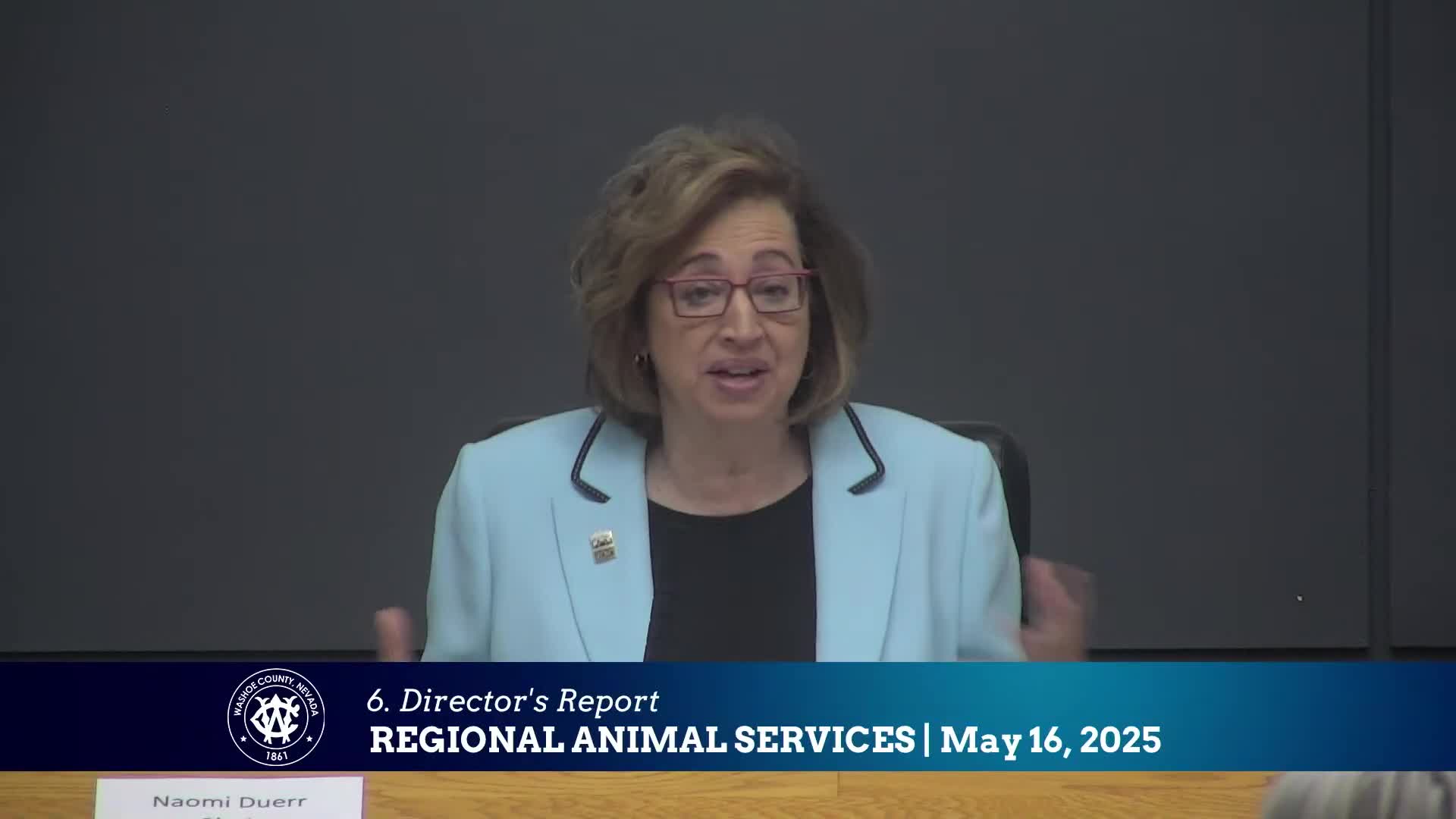Animal Services reports decreases in shelter intake and successes in field reunifications
May 17, 2025 | Washoe County, Nevada
This article was created by AI summarizing key points discussed. AI makes mistakes, so for full details and context, please refer to the video of the full meeting. Please report any errors so we can fix them. Report an error »

In the heart of Washoe County, the Regional Animal Services Advisory Board convened on May 16, 2025, to discuss pressing issues surrounding animal welfare and community engagement. As the meeting unfolded, the focus was clear: improving the efficiency of animal movement and care, while also celebrating recent successes in animal reunification.
The meeting began with a reminder of the fundamental mission of animal services—how to effectively move animals through the system. This foundational task is crucial for ensuring that animals receive the care they need while minimizing their time in shelters. The board acknowledged the importance of updating the Public Service Agreement (PSA) to enhance collaboration with partners like the Nevada Humane Society (NHS).
As the discussion shifted to statistics from the third quarter of the fiscal year, the board reported a notable decrease in animal intake. Specifically, there was a 17% drop in cat intakes, totaling 635, and a 5% decrease in dog intakes, with 1,298 dogs entering the shelter. This decline was welcomed by the board, as it reflects a positive trend in community awareness and responsible pet ownership.
The efficiency of animal care was also highlighted, with dogs averaging a stay of just 7.4 days in the shelter and cats at 5.6 days. These figures are significant, as they indicate a swift turnover that allows for more animals to be cared for and adopted. The board emphasized the importance of microchipping, noting that 47% of dogs and 17% of cats entering the shelter were already microchipped. Efforts to increase microchipping among cats were particularly stressed, given their tendency to roam.
A key highlight of the meeting was the success of field reunifications. The board reported that 621 animals were picked up by field staff, with 271 of those being reunited in the field—an impressive 44% success rate. This figure marks the highest rate of field reunifications since 2021, attributed to enhanced efforts by field staff, including the use of microchip scanners and a new pet ID tag initiative. These strategies not only reunite pets with their owners but also save significant costs associated with shelter care.
However, the board acknowledged challenges in reunifying animals once they enter the shelter system. Only 31% of animals brought in by Good Samaritans were reunited after impound, highlighting the need for continued community education and support.
The meeting concluded with a discussion on partnerships with various rescue organizations, which play a vital role in transferring animals from the shelter to new homes. The Nevada Humane Society remains the primary partner, transferring nearly 90% of animals, while other local rescues also contribute significantly.
As the board wrapped up, the sense of commitment to animal welfare and community engagement was palpable. With ongoing efforts to improve animal care and reunification rates, Washoe County is poised to continue making strides in fostering a compassionate environment for its furry residents.
The meeting began with a reminder of the fundamental mission of animal services—how to effectively move animals through the system. This foundational task is crucial for ensuring that animals receive the care they need while minimizing their time in shelters. The board acknowledged the importance of updating the Public Service Agreement (PSA) to enhance collaboration with partners like the Nevada Humane Society (NHS).
As the discussion shifted to statistics from the third quarter of the fiscal year, the board reported a notable decrease in animal intake. Specifically, there was a 17% drop in cat intakes, totaling 635, and a 5% decrease in dog intakes, with 1,298 dogs entering the shelter. This decline was welcomed by the board, as it reflects a positive trend in community awareness and responsible pet ownership.
The efficiency of animal care was also highlighted, with dogs averaging a stay of just 7.4 days in the shelter and cats at 5.6 days. These figures are significant, as they indicate a swift turnover that allows for more animals to be cared for and adopted. The board emphasized the importance of microchipping, noting that 47% of dogs and 17% of cats entering the shelter were already microchipped. Efforts to increase microchipping among cats were particularly stressed, given their tendency to roam.
A key highlight of the meeting was the success of field reunifications. The board reported that 621 animals were picked up by field staff, with 271 of those being reunited in the field—an impressive 44% success rate. This figure marks the highest rate of field reunifications since 2021, attributed to enhanced efforts by field staff, including the use of microchip scanners and a new pet ID tag initiative. These strategies not only reunite pets with their owners but also save significant costs associated with shelter care.
However, the board acknowledged challenges in reunifying animals once they enter the shelter system. Only 31% of animals brought in by Good Samaritans were reunited after impound, highlighting the need for continued community education and support.
The meeting concluded with a discussion on partnerships with various rescue organizations, which play a vital role in transferring animals from the shelter to new homes. The Nevada Humane Society remains the primary partner, transferring nearly 90% of animals, while other local rescues also contribute significantly.
As the board wrapped up, the sense of commitment to animal welfare and community engagement was palpable. With ongoing efforts to improve animal care and reunification rates, Washoe County is poised to continue making strides in fostering a compassionate environment for its furry residents.
View full meeting
This article is based on a recent meeting—watch the full video and explore the complete transcript for deeper insights into the discussion.
View full meeting